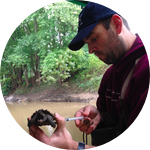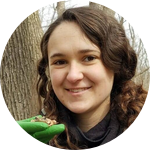About This Project
Amphibians are experiencing a global extinction event. Nearly 200 species are thought to be extinct, and two-thirds of amphibian species are threatened with extinction. The Chytrid fungus has received a lot of attention, while the deadly ranavirus has been overlooked. We will develop a way to determine if a ranavirus outbreak has occurred by detecting how much DNA from the virus is in wetlands (this DNA is called environmental, or eDNA).
Ask the Scientists
Join The DiscussionWhat is the context of this research?
Ranaviruses have a global distribution. They have caused population declines in amphibian species because when an outbreak occurs hundreds of animals die very rapidly. However, researchers don't know the spatial distribution or temporal frequency of these disease events. eDNA can help us address this gap in our knowledge.
Environmental DNA (eDNA) is DNA that is detected in environmental samples like soil and water. Ranavirus is waterborne, so its DNA will be detected in the water samples we collected. A recent study used eDNA to show that viral DNA in water increases during an outbreak. This means that using eDNA to detect the virus in water can be used as an effective monitoring tool; however, more work is needed to fully develop this tool.
What is the significance of this project?
All amphibian populations are threatened by the world-wide emergence of ranaviruses. However, many conservation actions are costly. Therefore, environmental agencies need to know where this disease occurs most frequently to focus research and conservation efforts. Often, monitoring for this disease requires tissue samples to confirm ranavirus infection. Getting tissue samples is lethal; and trapping amphibians can cause stress and unintended mortality. These negative effects need to be minimized in populations with endangered species. eDNA is cost-effective compared to traditional field techniques and can be used in any amphibian population without disturbing the animals. Using eDNA to detect ranavirus can tell land managers where resources are most needed to save amphibian populations.
What are the goals of the project?
Our goal is to develop a way to use eDNA to monitor freshwater wetlands for ranavirus. To do this, we need to determine how frequently a water sample is required to positively detect a ranavirus outbreak, and estimate the background detection rate.
We will estimate the sampling frequency and the background detection rate by extracting eDNA from 100 water samples that were collected in 2017. We will measure how many copies of virus DNA were in the sample using a method called quantitative polymerase chain reaction (qPCR). We will select 20 samples during the period before any disease was detected to estimate the background prevalence, and the remaining 80 samples will be used to analyze trends in ranavirus abundance. These trends will tell us how often a sample is required for monitoring.
Budget
During the spring of 2017, six wetlands were monitored to assess the size and health of the amphibian populations using the wetlands for breeding habitat. This research was supported by two State Wildlife Grants from the Illinois Department of Natural Resources (IDNR FWS T-108-R-1 and IDNR FWS T-104-R-1). These grants provided the funds for transportation, building materials, salaries for technicians, and for health assessments on animals. However, these grants did not provide money for detecting virus DNA in the environment.
We were collecting water samples from these wetlands throughout the monitoring when two of the six wetlands experienced a ranavirus outbreak. The budget items detailed above would allow us to purchase the materials necessary to go back to those water samples, test them, and see what was happening to the amount of virus in the wetlands during the outbreaks, and figure out how that was different to wetlands that did not experience an outbreak.
Endorsed by
 Project Timeline
Project Timeline
We collected water samples during the 2017 field season (February through August). We have validated our extraction and qPCR protocol in the spring of 2018. After receiving funds, we will extract the DNA in the Winter of 2018, amplify the extracts in early 2019, and submit a manuscript for publication by July of 2019. This manuscript will help researchers and land managers develop protocols for eDNA-based disease monitoring.
Feb 28, 2017
Collect water samples prior to disease signs
May 01, 2017
Collect water samples during naturally occuring ranavirus die-off
Jun 27, 2017
Collect water samples after naturally occurring ranavirus die-off
Mar 13, 2018
Validate use of FV3 TaqMan Primers in qPCR amplification of eDNA
Aug 21, 2018
Project Launched
Meet the Team
Kelsey Low
I studied Integrative Biology at the University of Illinois (2015) and stayed to pursue graduate studies. I am co-advised by Dr. Christopher Phillips, and Dr. Matthew Allender DVM. My dissertation focuses on ranavirus in amphibian populations in East-Central Illinois. I have always been profoundly interested in disease processes, and feel fortunate to be able to combine that interest with my passion for conservation.
I work with the Wildlife Epidemiology Laboratory at the University of Illinois College of Veterinary Medicine and the Population and Community Ecology Laboratory at the Illinois Natural History Survey.
Additional Information
The frequency that samples are required could be as low as every two weeks, or it could be as high as every day. We are in a good position to answer this question because we collected water from the six wetlands every other day.
eDNA detects a small piece of the viral DNA, which may be left over after a virus dies in the water. This means that we will detect small amounts of virus even when there was no outbreak. The amount of this left-over DNA we detect is called background detection and will be the threshold for future ranavirus monitoring projects.
Project Backers
- 30Backers
- 29%Funded
- $1,136Total Donations
- $37.87Average Donation


